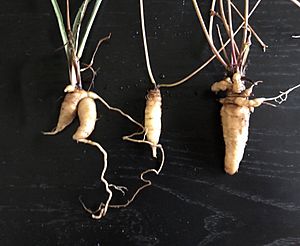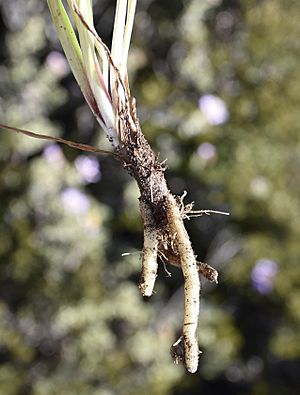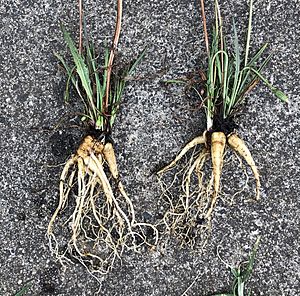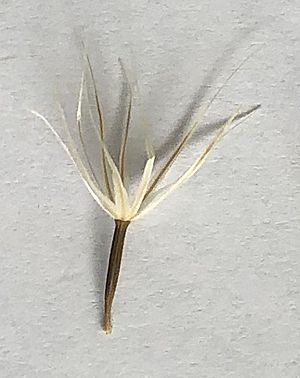Murnong facts for kids
Murnong and yam daisy are common names for special plants called Microseris walteri, Microseris lanceolata, and Microseris scapigera. These plants were a very important food source for Indigenous people in Australia for thousands of years.
The roots of murnong plants were eaten in large amounts by Indigenous people. This continued until the 1840s. At that time, European settlers started using the murnong lands for sheep farming. This greatly reduced the amount of murnong available.
The scientific names of these three murnong species were often mixed up. This was because they were classified under different names for a long time. In 2016, a botanist helped to make their names clear. Murnong is often described as having a sweet root. This is true for Microseris walteri. However, the other two plants have roots that taste bitter.
Contents
Understanding Murnong Plants
For over 30 years, murnong was known by different names like Microseris sp., Microseris lanceolata, or Microseris scapigera. A botanist from the Royal Botanic Gardens Victoria, Neville Walsh, made the scientific name Microseris walteri clear in 2016. He also explained the differences between the three species.
| Feature | Microseris walteri | Microseris lanceolata | Microseris scapigera |
|---|---|---|---|
| Roots | One thick, fleshy root that grows into a single, round or oval tuber. This tuber is replaced every year. | Several fleshy roots that are long and thin. They branch just below the ground. | Several long, thin roots. They usually branch close to the leaves. |
| Images of roots | |||
| Fruit (Capsela) | Usually less than 7mm long. | Usually less than 7mm long. | Mostly 7–10 mm long. |
| Images of seeds | |||
| Pappus bristles | About 10 mm long, 0.5–1.3mm wide at the bottom. | 10–20 mm long, about 0.3–0.5 mm wide at the bottom. | 30–66 mm long. |
| Images of flowers | |||
| Joined petals (Ligule) | Usually more than 15mm long. | Usually more than 15mm long. | Up to 12mm long. |
| Where it grows | Lowlands of southern Western Australia, South Australia, New South Wales, ACT, Victoria, and Tasmania. | Rarely on basalt soils; found in alpine and subalpine areas of New South Wales, ACT, and Victoria. | Mostly from basalt plains of western Victoria and high places in Tasmania. |
| Taste of roots | Sweet-tasting, whether eaten raw or cooked. | Bitter, a bit stringy, and not very tasty. | A bit stringy, and slightly bitter, but okay to eat. |
Indigenous Names for Murnong
The word "murnong" comes from the Woiwurrung language. It was used by the Wurundjeri people and other groups of the Kulin nation. However, this plant has many other names in different Australian Indigenous languages.
Here is a list of some Indigenous names for murnong, along with the language groups and where the names were recorded:
- murnong, mernong, mirr-n'yong, myrnong, wuleli. Woiwurrung (Melbourne)
- dirrinan. Wiradjuri (Mudgee, NSW)
- dalu-mlarng, mlang, moit-bar-dyul. Gunai/Kurnai (Gippsland, Vic)
- kandara. Kaurna (Adelaide, SA)
- keerang, yuwatch (cooked root). Peek Whuurong (Port Fairy, Vic)
- kool-an-gur. Wannin (Wannon, Vic)
- maiela. Bangerang (Echuca, Vic)
- maiyilla. Yorta Yorta (Echuca, Vic)
- maranong. Wathawurrung (Trawalla, central Vic)
- mar-o-ngire, moor-na Booandik (South East, SA)
- midyini. Dharug (Sydney)
- meerwan. Wemba Wemba (Lake Bogal, Vic)
- me-wan. Ngarigo (alpine, NSW)
- mingar (Mudgee, NSW)
- mo-i-yool. Ngoorialum (Colbinabbin, Vic)
- mo-ner, moo-nar. Dja Dja Wurrung (East of Grampians)
- moonang (Bacchus Marsh, Vic)
- moonya (Lake Albacutya, Vic)
- mooranong (Hamilton, Vic)
- munja. Wergaia (Mallee, Vic)
- munya, bam-munya. Wotjobaluk (Lake Hindmarsh, Vic)
- murning Wathawurrung (Geelong, Vic)
- muurang, yuwatch (cooked root). Kuurn Kopan Noot (North of Port Fairy, Vic)
- myrnong (Mortlake, Vic)
- ngamko. Thura-Yura (Lower Murray, SA)
- ngarridyu. Wiradjuri (Murrumbidgee, NSW)
- njamang. Southern Ngarigu (Gippsland, Vic)
- pun-nin. Waverang (West of Mt Cole, Vic)
- pun'-yin, taluum. Chaap Wuurong (Mt Rouse, Vic)
- tao. (Lachlan River, Regent Lake, Bogan River, NSW)
- thabor. Watiwati (Tyntynder, Vic)
- yerat. (Lake Condah, Vic)
How Murnong Was Used and Grown
The edible roots of murnong plants were once a very important food for Aboriginal Australian people. This was especially true in the southern parts of Australia. Indigenous women would dig for these roots using a digging stick, also called a yam stick. They would carry the roots in a special bag called a dillybag.
One way to cook the roots was to place the whole dillybag of tubers into an earth oven, called a mirnyong. Another cooking method involved placing heated clay pieces above and below the roots. The steam and moisture from this helped to keep the vegetables from drying out and shrinking.
Early Records of Murnong
In 1803, a convict named William Buckley escaped from a settlement in Victoria. He lived among the Wathaurong people for many years. Buckley said that an important food for him was a root the local people called "Murning." He described it as looking, feeling, and tasting much like a radish.
James Malcolm, an early settler in Port Phillip, spoke to the NSW parliament in 1845. He said that a "nutritious root" that Indigenous people liked had greatly decreased. He believed this was because sheep and cattle were grazing on the land. He noted that the plant had a "beautiful yellow flower" and its native name was "murnong."
Malcolm also mentioned Buckley in his description. He said the root tasted good and had a milky substance when squeezed. Buckley told him that a person could live on the root for weeks. He had dug up many of them for food.
In 1835, a Tasmanian settler named John Batman set up a camp at Indented Head. This was for a land company. While Batman went back to Tasmania, the people at the camp started running low on food. So, they began to eat murnong, just like the local people. A servant named William Todd wrote, "We have commenced eating roots the same as the natives do."
Surveyor and explorer Thomas Mitchell saw a group of Aboriginal people in 1835. They were growing and harvesting murnong roots with special tools near the Hopkins River.
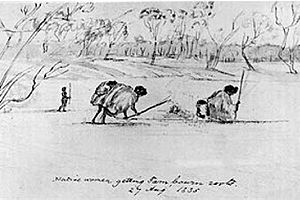
Impact of Sheep and Cattle Grazing
When European settlers brought cattle, sheep, and goats to Australia, it caused big problems for murnong. These animals ate the plants, leading to the near disappearance of murnong. This had a terrible effect on Indigenous communities. They relied on murnong for a large part of their food.
Mitchell had noticed that "the cattle are very fond of the leaves of this plant, and seem to thrive upon it." Sheep were even more damaging. This was because murnong grew most often on the open plains and in forests where sheep were introduced.
Changes in the Hawkesbury River Region
From 1794 to 1816, British soldiers were involved in conflicts with Indigenous clans near the Hawkesbury River and west of Sydney. In 1794, four hundred British settlers moved into the area. They started building farms along the river, and some soldiers also set up farms. The areas where midyini (murnong) yams grew were removed. Instead, corn was planted.
When the corn was ready to be harvested, there were reports of Aboriginal people wanting to take the corn. A Darug man, Chris Tobin, wrote that soldiers were sent to the area. They were told to act in a way that would make Aboriginal people leave. Soldiers found Indigenous camps at night, and people were harmed. An unknown number of people died. Tobin said that five prisoners were taken to Parramatta. One woman was carrying a baby who had been injured. The baby later died in the hospital. The prisoners were released a few days later.
To remember the difficulties and changes in the region, a Memorial Fire Place was built in 2002. It is on the land of the St John of God Hospital in North Richmond, NSW.
Murnong in Art
In 2019, the National Gallery of Victoria asked artist Yhonnie Scarce and Melbourne architecture studio Edition Office to create a large sculpture. It is called 'In Absence'. This artwork makes people think about why murnong is now missing from Victoria. Before European settlement, murnong was very common there.
The artwork has a wooden tower that rises from a field of kangaroo grass, murnong, and a path of crushed basalt rock. The tower is 9 meters tall and 10 meters wide. It is covered in dark-stained wood. A narrow opening cuts through the tower, creating a space inside. In each of the two curved rooms inside, hundreds of shiny, black glass murnong roots fill the walls. They sparkle when sunlight shines through.


